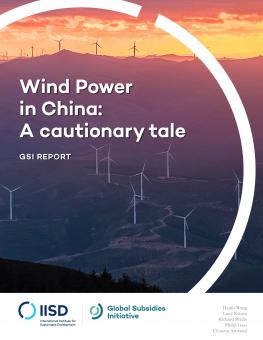
Wind Power in China: A cautionary tale
This reports looks at some of the challenges that China has faced in expanding wind power. It identifies the ways that the government has sought to address these challenges and offers recommendations to support expanded wind power in China and elsewhere.
Over the last 10 years, China has seen an unprecedented deployment of wind power, with capacity growing from 1.26 gigawatts (GW) in 2005 to 91.4 GW at the end of 2013.
Notwithstanding this impressive growth, the problems encountered have included uneven resource distribution, disjunctions in location of power supply and demand, the need to expand domestic industry and the need to achieve a proper balance of financial supports. These issues have been addressed with some success; however, others persist, such as delays in connection of wind power to the grid and curtailment of generated power from connected farms. These need to be resolved to ensure the success of future wind power development in the country.
This report takes a closer look at the drivers behind the impressive wind power development in China in order to understand the complex connection between the policy goals, policy measures and development impact. In particular, it considers two related issues that have been encountered—curtailment of generation and delays in connection of projects—and how these are being addressed. The report aims to identify the lessons to be learned to inform future policy measures in China and elsewhere.
The analysis finds that there are technical, governance and economic factors that have given rise to these two prominent issues. With respect to delayed connection, the technical factor is that the expansion of national wind power resources has outpaced the construction of transmission. On the governance side, we see that construction plans for wind farms and grids are not aligned, grid construction was not emphasized enough, and there was insufficient state-level oversight and coordination between the national and state levels. Economically, grid operator supports are weaker than those for power development.
The government has acknowledged these issues and taken steps to address them. The 2012 White Paper on China’s energy policy highlights the need to increase grid capacity. The 12th Five-Year Plan (FYP) also refers to the need to coordinate development of both grid and capacity, and there is a suggestion that the next FYP will address planning, development and integration with the goal of resolving curtailment.
In some ways, China’s current challenges with wind power can be considered in terms of the country being a victim of its own success. Capacity has expanded rapidly, and the domestic industry has grown at an impressive rate. Rather than a lack of supply, the challenges of curtailment and delayed connection are issues of getting supply to demand. This could be seen as an enviable problem by many countries looking to expand renewables, but it is a problem nonetheless.
China has already taken steps to address some of these challenges, and the lessons and suggestions in this report could accelerate addressing the challenges of curtailment and delayed connection. Just as importantly, the issues China has faced, as one of the early global actors on wind power, provide important guidance for other countries and project developers looking to replicate their successes—and limit their challenges—in other countries.
You might also be interested in
Heatwaves to hit China once every 5 years as global extreme weather events multiply, study finds
Record-breaking heatwaves that have scorched North America, Europe and China are set to worsen in future unless the world stops burning fossil fuels, according to a study by the World Weather Attribution (WWA) academic initiative.
Transition from fossil fuels to renewable energy can pose fiscal challenges for India: study
The global transition away from fossil fuels to renewable energy sources could trigger financial challenges for India and major developing countries such as Russia, Brazil and China because of their high dependence on revenues from fossil fuel, according to a study by the International Institute for Sustainable Development (IISD).
IISD Report: Shifting Away from Fossil Fuels Could Lower BRIICS Nations' Revenues
A new report by the International Institute for Sustainable Development (IISD), titled Boom and Bust: The Fiscal Implications of Fossil Fuel Phase-Out in Six Large Emerging Economies, looks at the potential financial ramifications of phasing out fossil fuels in six emerging economies — Brazil, Russia, India, Indonesia, China, and South Africa (BRIICS). They must begin adjusting their fiscal policies to account for declining fossil fuel use or risk a $278 billion revenue gap by 2030.
India, 5 others face fall in fossil fuel revenues
As the global clean energy transition gathers pace, six emerging economies need to start adjusting their fiscal policies now to account for declining fossil fuel use-or risk a $278 billion gap in revenues by 2030, equivalent to the combined total government revenues of Indonesia and S. Africa in 2019, according to a new report by the International Institute for Sustainable Development.